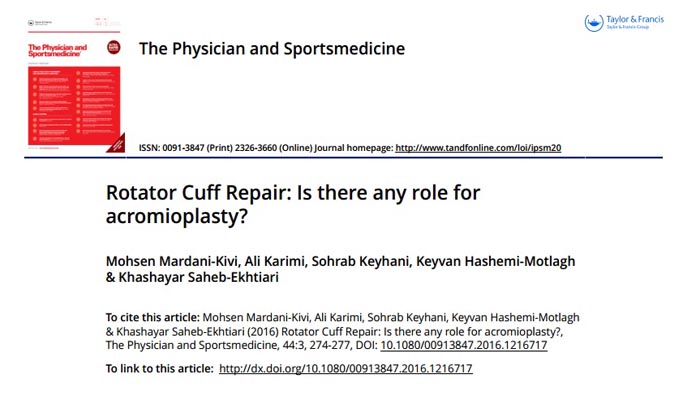- تاریخ درج : ۲۸ فروردین ۱۳۹۶
- تعداد بازدید: 2932
- نویسنده : dr.mohsen mardani-kivi
-

ABSTRACT
Objectives: Acromioplasty has been one of the most common techniques amongst orthopedic surgeries in the past decade. However, its efficacy in arthroscopic surgeries of rotator cuff repair is still debatable. The purpose of this study is to compare the arthroscopic rotator cuff repair with or without acromioplasty in patients with complete rotator cuff tear.
Methods: In this prospective cohort study, patients with complete rotator cuff tear (acromion type II or III Bigliani) and a history of failure to the conservative treatment for at least 6 months were evaluated for eligibility. Patients, based on the time interval, were placed in one of two groups: arthroscopic rotator cuff repair with (RCR-A group) and without acromioplasty (RCR group). Patients were assessed for two years in term of pain intensity by VAS criteria and shoulder functional status by Quick-DASH, Constant score and simple shoulder test criteria.
Results: In the baseline assessment, RCR-A group (34 patients) and RCR group (33 patients) were similar. Comparing patients in two groups in relation to SST, Quick-DASH and VAS scores preoperatively showed there is no significant difference between the two groups. The SST, Quick-DASH and VAS scores improved significantly in both groups at both the 6-month and 2-year follow-ups (all P < 0.001). The extent of progress in the functional scores was similar in both groups (P > 0.05).
Conclusion: Arthroscopic rotator cuff repair without acromioplasty may be as reliable and useful as conventional rotator cuff repair with acromioplasty. Thus, acromioplasty cannot be recommended as a routine technique in every rotator cuff repair.
-